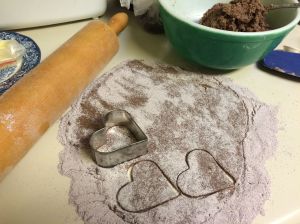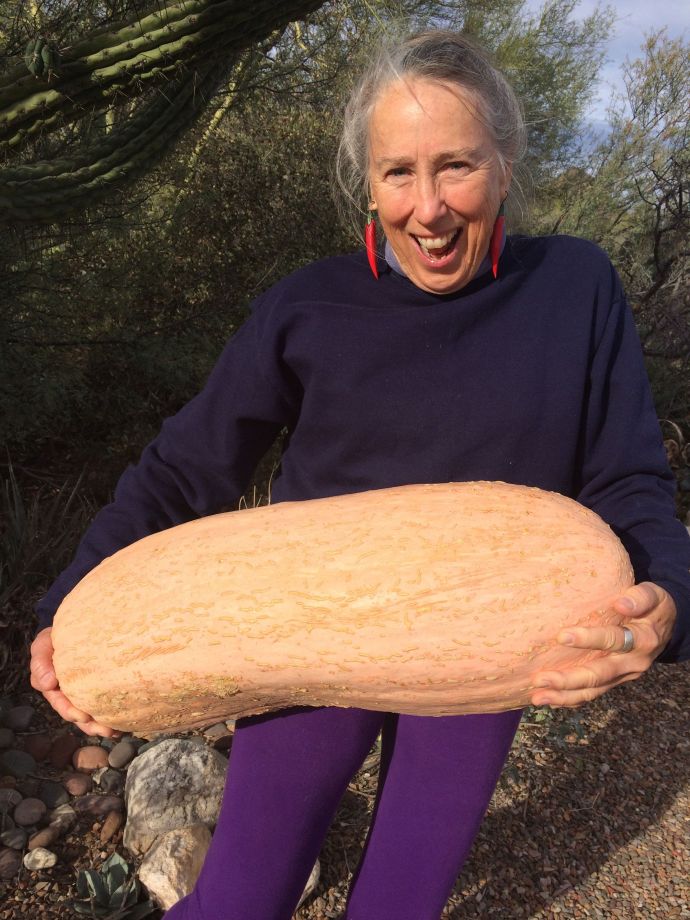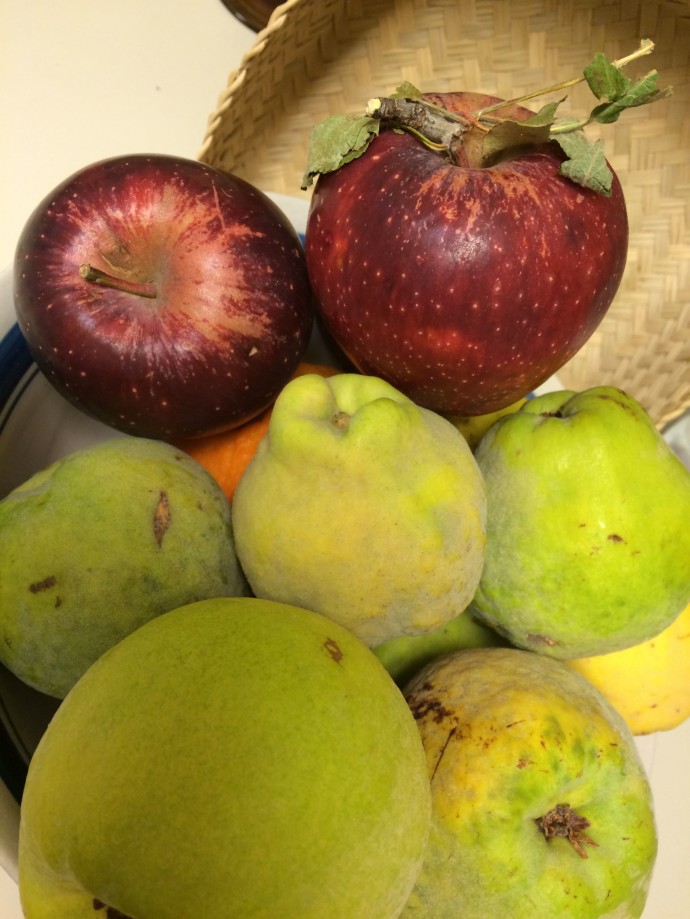
An Heirloom Fruit Harvest: Padre Kino’s Membrillo Fruit from my garden with Star King Old Fashioned Double Delicious Apples from Slide Rock State Park heirloom orchard (MABurgess photo)
In both the low Sonoran Desert and in the higher Southwest, fruits are hanging on the trees ready for harvest. At Mission Garden the quince trees, better known as membrillo, are bearing their last sturdy fruits. Mission Garden was the site of a wonderful celebration of membrillo in October with talented cook Josefina demonstrating how to make cajeta de membrillo, our sweet autumn dessert delicacy.

Membrillo (Quince) trees heavy with fruit at Mission Garden in Tucson, Arizona, near A-Mountain–Come visit any Saturday morning!

Membrillo is a perfect food-giving tree for low desert as it can can handle heat–great for a kitchen garden
Tia Marta here to share what is happening in my kitchen these days, bringing together some of my most admired heirloom grain and fruit ingredients–both cultivated and wild–knowing that I have guests coming for the holidays who need a little taste of LOCAL!
It is pie time in our household. And today it is Membrillo-Apple Pie with White Sonora Wheat-Mesquite pie crust! I mean, how much more local can one get?
This was the year that our five-year-old quince tree, which we purchased from Desert Survivors Nursery Kino Fruit-tree Project, and which we planted a couple of years ago in our backyard, decided to flower and set fruit–just enough this time to make a couple of pies. We look forward to the amazing productivity in future years that the Mission Garden quince trees are already showing. Quince or membrillo fruits look like a cross between yellow apples and pears but are far more sturdy than either of those. Before ripening they are covered with fuzz and, as they lose it and become shinier and more yellow, you know they are ripening.
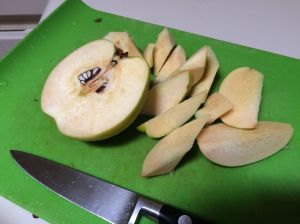
Because they are harder than other fruit, be sure to cut membrillo with extra care. Expect this to result in not-so -symmetrical slices–no problem inside a pie.
Even when this aromatic rose-family fruit is ripe, its somewhat sweet tissue never really softens. They may feel and taste granular, similar to some pear varieties. But they are substantial food, full of good potassium, vitamin C, dietary fiber, and iron. In other regions, quince has been used with apples to make jellies as it aids the gelling process. Since the time of the missionaries into Pimeria Alta, the traditional way of preparing membrillo here is to cook it down with raw sugarcane sugar to make the cajeta confection. (A detailed report of cajeta de membrillo will make a neat separate post.)
I chose to mix membrillo with its sweet cousin, heirloom local apples, to create a Southwestern version of the all-American pie. From the neat old Pendley Homestead at Slide Rock State Park in Oak Creek Canyon near Sedona, I obtained the deep maroon-skinned apples shown above from a 1912 orchard. From the English Family Orchards at Willcox I added a few little galas. Don’t ever be ashamed to ask orchardists at farmers’ markets if they have any “rejects” for sale. Many a tasty apple gets tossed because it has a blemish or knick. Such apples can become a rewarding gift in pies, apple-brown-betty, or applesauce.

Pressing mesquite/whiteSonora wheat dough into pie pan

Mesquite meal and white Sonora wheat make a fabulous pie-crust! It is not as elastic as store-bought crusts so be careful in rolling it onto your pie pan. Shown here is a very flat spatula I use as an assist.
Next step, after growing, harvesting, slicing the heirloom fruits, is getting dusted by making my local heirloom Mesquite/White Sonora Wheat Pie Crust (recipe following):
[Kids, don’t try this culinary photographic technique at home. Your one-handed iPhone will get really sticky. Mine will never be the same.]
Ingredients for heirloom wheat pie crust:
1 1/2 cups freshly milled whole, organic White Sonora Wheat flour*
1/2 cup freshly milled local velvet mesquite meal**
1 tsp Real-salt or sea salt
2/3 cup shortening (I use organic butter)
5-7 Tbsp ice water
*Organic, fresh-milled white Sonora wheat flour is available for your holiday baking from our Flor de Mayo booth at Sunday St Philips Farmers Market, or by contacting us at info@flordemayoarts.com or 520-907-9471 to order it ahead. **Freshly-milled velvet mesquite pod meal (flour) is available via the same Flor de Mayo contacts above. Both kinds of heirloom flour are available at a special Heirloom Grains event this coming SATURDAY November 21 at the NativeSeeds/SEARCH store, 3061 N Campbell, Tucson–the public is invited 10am-2pm.
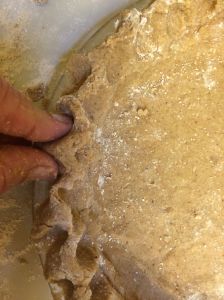
Pinching a tall scalloped edge of my mesquite/heirloom wheat pie crust–This provides a retaining wall so juicy filling will not overflow while cooking.
Directions for heirloom wheat pie crust (lattice top):
Sift dry ingredients. Cut in shortening into small pea size lumps. Sprinkle in tablespoons of ice water gradually, mixing with a fork. Form 2 balls of dough. Dust each ball with more white Sonoran wheat flour. Flatten each out on a well floured board and roll with rolling pin or bottle. Use rolling pin as in the illustration, to lift lower pie crust dough onto pie pan. Press in with fingers. Keep second ball of dough for working on after pie filling has filled the lower crust. [See recipe for Membrillo/Apple Pie Filling below.]
With second dough ball, roll out as before then cut in 1/2 inch wide strips to lay in basket-weave pattern atop the pie filling to allow filling to lower as it cooks.
Membrillo/Apple Pie Filling ingredients:
(Cook ahead slices and chunks of 4-5 membrillo fruits, washed, then cut with or without skin. Boil in good drinking water for 20 minutes or until soft. I am one of those crazies who thinks fruit skins are healthy and full of phytonutrients, so I leave the colorful fruit skins on.)
2 cups sliced membrillo fruit, pre-cooked (reserve liquid for other gelled salads)
2 cups thinly sliced heirloom apples
1/2 cup organic cane sugar
1/2 cup organic brown sugar
2 Tbsp organic heirloom white Sonora Wheat flour
1/2-1 tsp ground cinnamon
dash sea salt
1-2 Tbsp organic butter
juice of one small heirloom sweet lime (I got mine from the Friends of Tucson’s Birthplace Mission Garden booth at the Thursday Santa Cruz farmers market at the Mercado San Agustin, West Congress, Tucson)
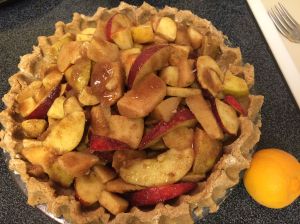
Membrillo/apple pie filling in shell ready to bake. Check out the heirloom sweet lime adjacent–with the dimple–this one from Mission Garden.
Membrillo/Apple Pie-Filling Directions: Preheat oven to 400 degrees.
Combine sugars, flour, cinnamon, salt, then mix with the sliced apples. Fill uncooked pastry crust (shell) with mixture. Squeeze the sweet lime juice over the filling and place dollups of butter on top. Place lattice strips of the mesquite/whiteSonorawheat dough across the top of the filling as in picture below. BAKE for 40-50 minutes or until the crust looks golden brown. Note: mesquite meal has natural complex sugars which may caramelize or brown faster than white flour so keep an eye on it after 40 minutes. The one in my photo got a little too done for my taste, but it will still be fabulous.

Membrillo/heirloom apple pie with lattice crust of mesquite/white Sonora wheat –hot and ready to serve–To the left in photo is flour milled from BKWFarms wheat-berries.
There will be several ancient grains available at our upcoming Celebration of Heirloom Grains this SATURDAY at the NativeSeeds/SEARCH Store. Put it on your calendar and dig out your favorite recipes!

Heirloom purple prairie barley available at Flor de Mayo booth,St Philips Farmers Market and at the NSS Grain Event Saturday!
In addition to our native Mesquite Flour, there will be such fresh lovely grains as organic Hard Red Wheat grown by BKW Farms in Marana which is superb for breads. Our organic white Sonora wheat is the best for pastries. Also available will be the ancient Purple Prairie Barley originally from Afghanistan, now from Hayden Mills.
For the knowing baker, milling the whole grain fresh creates a totally different and wondrous effect to breads and pastries because the enzymes and other constituents in the grain remain “lively” for only a few days after milling. Come enjoy the milling process right before your eyes and feel the vitality of the flour you can take home to bake with!
Our thanks go to the caring padres who first brought the grains to the desert Southwest, to the generations of farmers who continued to grow and save the grain, to NSS for “rediscovering” and conserving them so carefully for the future, and to new farmers like San Xavier Farm Coop, BKWFarmsInc, Ramona Farms, and Hayden Flour Mills for multiplying them for our nutrition, enjoyment, and sustainable desert living!
For more info please call NativeSeeds/SEARCH at 520-622-5561 or Flor de Mayo at 520-907-9471. See you at the Milling and our Celebration of the Heirloom Grains!!

Magdalena heirloom barley grown at Mission Garden, Tucson

A savory pilaf made with heirloom purple prairie barley–watch for future recipes–Whole grain available at the Flor de Mayo booth, Sunday St Philips market, and at Saturday’s Heirloom Grain Celebration












































































